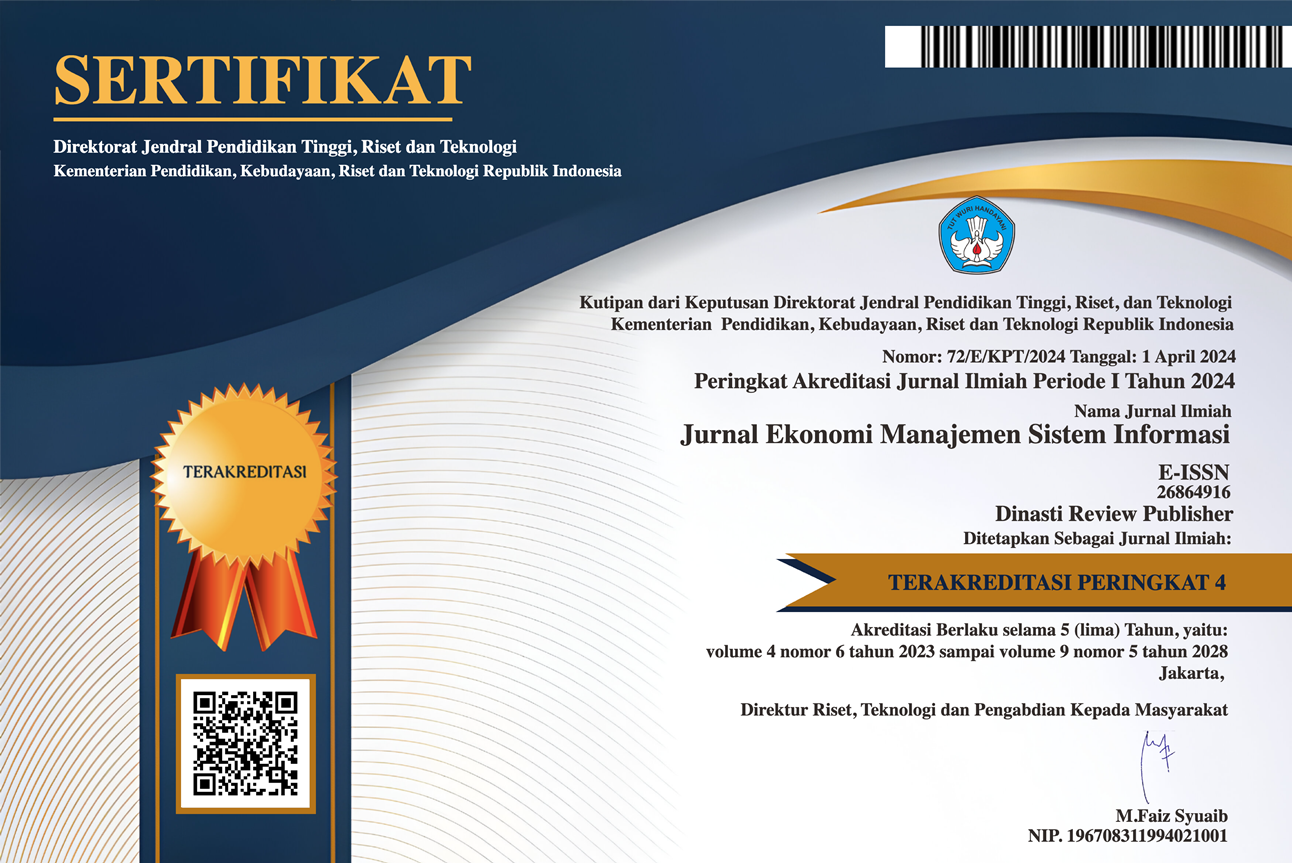Faktor Penyebab Internal Mobility: Studi Literatur
DOI:
https://doi.org/10.38035/jemsi.v6i5.4962Keywords:
Internal Mobility, Manajemen SDM, Pengembangan KarierAbstract
Penelitian ini bertujuan untuk mengidentifikasi dan menganalisis faktor-faktor penyebab terjadinya mobilitas internal karyawan melalui pendekatan systematic literature review terhadap 25 artikel akademik yang diterbitkan antara tahun 2020 hingga 2024. Internal mobility didefinisikan sebagai perpindahan posisi karyawan dalam organisasi yang sama, yang mencakup promosi, rotasi, maupun transfer lintas fungsi. Hasil kajian menunjukkan bahwa mobilitas internal dipengaruhi oleh tujuh kelompok faktor utama: faktor individu, organisasi dan sistem, sosial dan jaringan, gender dan ketimpangan, psikologis, budaya dan kepemimpinan, serta faktor eksternal. Studi ini menyoroti pentingnya interaksi antara dimensi personal dan struktural dalam menentukan keberhasilan internal mobility, serta perlunya pendekatan kebijakan SDM yang inklusif dan strategis. Temuan ini memberikan kontribusi teoritis dan praktis dalam memahami dinamika pengembangan karier karyawan serta implikasinya terhadap manajemen talenta organisasi.
References
AbouAssi, K., Johnson, J. M., & Holt, S. (2019). Job Mobility Among Millennials: Do They Stay or Do They Go? Review of Public Personnel Administration, 41(2), 219. https://doi.org/10.1177/0734371x19874396
Alshaikhmubarak, A., Camara, N. D., & Baruch, Y. (2020). The impact of high-performance human resource practices on the research performance and career success of academics in Saudi Arabia. Career Development International, 25(6), 671. https://doi.org/10.1108/cdi-09-2019-0209
Arnold, J. D., Iddekinge, C. H. V., Campion, M. C., Bauer, T. N., & Campion, M. A. (2020). Welcome Back? Job Performance and Turnover of Boomerang Employees Compared to Internal and External Hires. Journal of Management, 47(8), 2198. https://doi.org/10.1177/0149206320936335
Avram, S., Harkness, S., & Popova, D. (2024). Gender and Parenthood Differences in Job Mobility and Pay Progression in the UK. Social Forces, 103(2), 429. https://doi.org/10.1093/sf/soae068
Bauwens, R., Denissen, M., Beurden, J. V., & Coun, M. J. H. (2021). Can Leaders Prevent Technology From Backfiring? Empowering Leadership as a Double-Edged Sword for Technostress in Care. Frontiers in Psychology, 12. https://doi.org/10.3389/fpsyg.2021.702648
Benson, A., & Rissing, B. A. (2020). Strength from Within: Internal Mobility and the Retention of High Performers. Organization Science, 31(6), 1475. https://doi.org/10.1287/orsc.2020.1362
Black, D. E., & Vance, M. D. (2020). Do First Impressions Last? The Impact of Initial Assessments and Subsequent Performance on Promotion Decisions. Management Science, 67(7), 4556. https://doi.org/10.1287/mnsc.2020.3703
Bode, C., Rogan, M., & Singh, J. (2021). Up to No Good? Gender, Social Impact Work, and Employee Promotions. Administrative Science Quarterly, 67(1), 82. https://doi.org/10.1177/00018392211020660
Bonet, R., Cappelli, P., & Hamori, M. (2020). Gender differences in speed of advancement: An empirical examination of top executives in the Fortune 100 firms. Strategic Management Journal, 41(4), 708. https://doi.org/10.1002/smj.3125
Bossi, F., Gruttola, F. D., Mastrogiorgio, A., D’Arcangelo, S., Lattanzi, N., Malizia, A. P., & Ricciardi, E. (2022). Estimating Successful Internal Mobility: A Comparison Between Structural Equation Models and Machine Learning Algorithms. Frontiers in Artificial Intelligence, 5. https://doi.org/10.3389/frai.2022.848015
Bourmault, N., & Anteby, M. (2020). Unpacking the Managerial Blues: How Expectations Formed in the Past Carry into New Jobs. Organization Science, 31(6), 1452. https://doi.org/10.1287/orsc.2020.1361
Cornelius, P. B., Gokpinar, B., & Sting, F. J. (2020). Sparking Manufacturing Innovation: How Temporary Interplant Assignments Increase Employee Idea Values. Management Science, 67(4), 2231. https://doi.org/10.1287/mnsc.2020.3673
Dlugos, K., & Keller, J. (2020). Turned Down and Taking Off? Rejection and Turnover in Internal Talent Markets. Academy of Management Journal, 64(1), 63. https://doi.org/10.5465/amj.2018.1015
Keller, J., Kehoe, R. R., Bidwell, M., Collings, D. G., & Myer, A. T. (2020). In With the Old? Examining When Boomerang Employees Outperform New Hires. Academy of Management Journal, 64(6), 1654. https://doi.org/10.5465/amj.2019.1340
Liu, J., Mao, Y., & Zhu, B. (2021). How does job mobility relate to work commitment among rural healthcare workers? a cross-sectional study in western China. BMC Health Services Research, 21(1). https://doi.org/10.1186/s12913-021-07166-w
Mishra, R. (2022). A Study on the Relationship between Technostress and Employee Creativity with Perceived Organizational Support. Information Management and Business Review, 14(2), 9. https://doi.org/10.22610/imbr.v14i2(i).3314
Ray, C. (2023). Internal Mobility: A Review and Agenda for Future Research [Review of Internal Mobility: A Review and Agenda for Future Research]. Journal of Management, 50(1), 264. SAGE Publishing. https://doi.org/10.1177/01492063231180826
Siedlok, F., Hibbert, P., & Whitehurst, F. (2020). Social network influences on employee responses to organizational withdrawals. Organization Management Journal, 17(1), 15. https://doi.org/10.1108/omj-01-2018-0498
Signoretti, A., Pederiva, L., & Zaninotto, E. (2021). Trading?off flexibility: Contingent workers or human resource practices? A configurational approach. Human Resource Management Journal, 32(1), 58. https://doi.org/10.1111/1748-8583.12394
Stadler, C., Helfat, C. E., & Verona, G. (2021). TRANSFERRING KNOWLEDGE BY TRANSFERRING INDIVIDUALS: INNOVATIVE TECHNOLOGY USAGE AND ORGANIZATIONAL PERFORMANCE IN MULTI-UNIT FIRMS.
Virgiawan, A. R., Riyanto, S., & Endri, E. (2021). Organizational Culture as a Mediator Motivation and Transformational Leadership on Employee Performance. Academic Journal of Interdisciplinary Studies, 10(3), 67. https://doi.org/10.36941/ajis-2021-0065
Westerman, J. (2021). Should I Learn or Should I Turn? Implications of Job Mobility for Subsequent Learning at Work. European Sociological Review, 37(6), 935. https://doi.org/10.1093/esr/jcab018
Wilcox, A., McDonald, S., Benton, R. A., & Tomaskovic?Devey, D. (2021). Gender inequality in relational position-taking: An analysis of intra-organizational job mobility networks. Social Science Research, 101, 102622. https://doi.org/10.1016/j.ssresearch.2021.102622
Yang, H., & Hu, P. (2023). Role of job mobility frequency in job satisfaction changes: the mediation mechanism of job-related social capital and person?job match. Humanities and Social Sciences Communications, 10(1). https://doi.org/10.1057/s41599-023-01657-3
Yankow, J. J. (2022). The effect of cumulative job mobility on early?career wage development: Does job mobility actually pay? Social Science Quarterly, 103(3), 709. https://doi.org/10.1111/ssqu.13161
Downloads
Published
How to Cite
Issue
Section
License
Copyright (c) 2025 Yayan Yuliandi Yunahar, Rahmi Fahmy, Harif Amali Rivai, Laura Syahrul

This work is licensed under a Creative Commons Attribution 4.0 International License.
Hak cipta :
Penulis yang mempublikasikan manuskripnya di jurnal ini menyetujui ketentuan berikut:
- Hak cipta pada setiap artikel adalah milik penulis.
- Penulis mengakui bahwa Jurnal Ekonomi Manajemen Sistem Informasi (JEMSI) berhak menjadi yang pertama menerbitkan dengan lisensi Creative Commons Attribution 4.0 International (Attribution 4.0 International CC BY 4.0) .
- Penulis dapat mengirimkan artikel secara terpisah, mengatur distribusi non-eksklusif manuskrip yang telah diterbitkan dalam jurnal ini ke versi lain (misalnya, dikirim ke repositori institusi penulis, publikasi ke dalam buku, dll.), dengan mengakui bahwa manuskrip telah diterbitkan pertama kali di Jurnal Ekonomi Manajemen Sistem Informasi (JEMSI).











































































